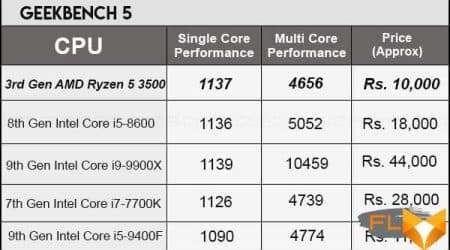


Exactly one year ago, AMD launched third-generation Ryzen processors based on the Zen 2 microarchitecture. This event was a turning point for the entire PC world: the Ryzen 3000 series not only turned out to be a good alternative to existing Intel processors, but in some cases offered even more attractive characteristics. , such as more cores with good IPC. As a result, over the past year, AMD was able to quite seriously oust its competitor in the processor market, especially if we talk about the segment of solutions designed for enthusiasts and advanced users who assemble computers on their own.
But time does not stand still, and after a year, AMD thought about making changes to the proposed CPU lineup. The need for them arose in light of the recent appearance of Comet Lake processors, which, despite another appeal by Intel to the long-suffering Skylake microarchitecture, were still able to demonstrate some progress by adding additional cores / threads and increasing clock frequencies. In addition, annual product updates are considered good form in the computer market: most manufacturers try to adhere to just such a cycle of announcements, and AMD is no exception.
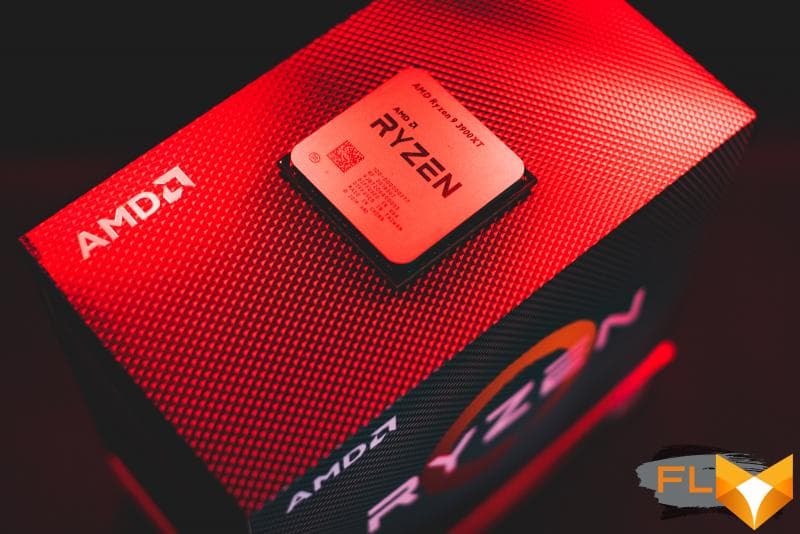
Of course, if AMD were to announce the next generation of its desktop processors based on the Zen 3 microarchitecture, it would look very impressive. But, unfortunately, she can’t do that yet. Although the first carriers of the new architecture are planned for this year, it is obvious that, at best, we will be able to meet the Ryzen 4000 of the Vermeer family only towards the end of it. Therefore, today we will not talk about Vermeer, but about Matisse Refresh – a minor update to the lineup of last year’s Ryzen 3000 processors, in which AMD slightly tightened the clock speeds and added a new XT index to the model names.
Despite the obvious marketing and image background of replenishing the Matisse processor family, AMD assures that the release of new models of the Ryzen 3000XT series has a solid technological basis. The company’s explanation is that over the past year, its manufacturing partner, semiconductor forge TSMC, has systematically improved the parameters of the 7nm process technology, and the silicon chips now leaving its assembly line have advanced in their properties relative to the original options. Therefore, now in the Ryzen 3000XT family, it simply brings the passport characteristics of the supplied processors in line with the capabilities of the available semiconductor crystals.
However, be that as it may, something else is more important for buyers. Ryzen 3000XT processors rise to the top positions in the lineup, not displacing existing offers from it, but shifting them lower in terms of price positioning. The Ryzen 3000XT subset includes three models: the 12-core Ryzen 9 3900XT, the octa-core Ryzen 7 3800XT, and the hexa-core Ryzen 5 3600XT. These processors received official prices of $499, $399 and $249, respectively. A year ago, these same prices were set for the Ryzen 9 3900X, Ryzen 7 3800X and Ryzen 5 3600X, but now these processors will naturally fall in price.
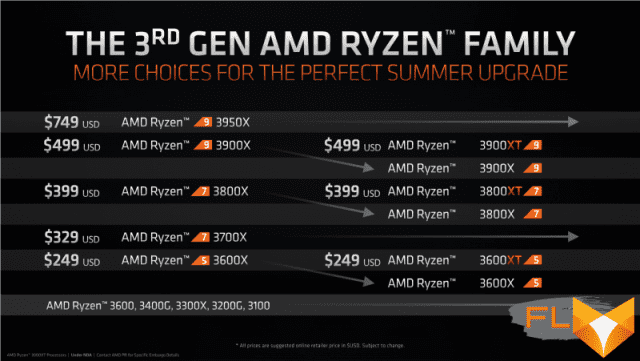
Thus, in honor of the anniversary of Matisse, AMD strikes a double blow at Intel’s positions at once. On the one hand, it offers newer processors with formally better characteristics, and on the other hand, it makes those processors by which Intel calibrated the prices of representatives of the new Comet Lake family cheaper. It turns out that AMD expects not to lose the initiative on the market for a second until the appearance of Vermeer, continuing to offer customers both more productive and more affordable processors.
⇡#Optimized 7nm process and updated Ryzen 3000 lineup
The whole plot with the release of the Ryzen 3000XT processors is built around some improvements in the 7nm process technology that AMD boasts of. The help documentation that the company distributed ahead of the release of the Ryzen 3000XT explicitly states that “AMD has been improving the cooking recipe” of third-generation Ryzen processors for the past year. The main goal of this process was to improve the parameters of 7nm transistors, which should lead to a decrease in their operating voltage and leakage currents and an increase in the achievable frequencies.
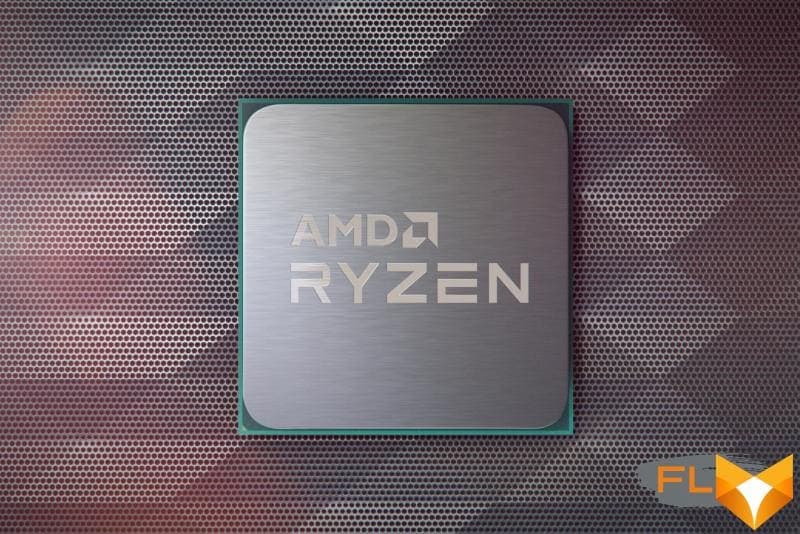
Enthusiasts are well aware that as they mature, technical processes really tend to improve, and formally the same processors, but released later, usually stand out from earlier brothers with better overclocking. It is this fact that AMD took advantage of to release the Ryzen 3000XT series. In these processors, the improvement in frequency potential that has accumulated over the past year has been officially legitimized: AMD has given them slightly higher frequencies compared to the original representatives of the Ryzen 3000 series and now directly says that the Ryzen 3000XT are built on 7-nm transistors “with definitely better properties” compared to previous conventional Ryzen 3000 processor transistors.
However, one should not hope for any radical breakthroughs in operating frequencies. We are talking only about a small increase in the maximum frequency in turbo mode, which reaches 100-200 MHz. At the same time, the base frequencies of the Ryzen 3000XT remain the same as those of their predecessors.
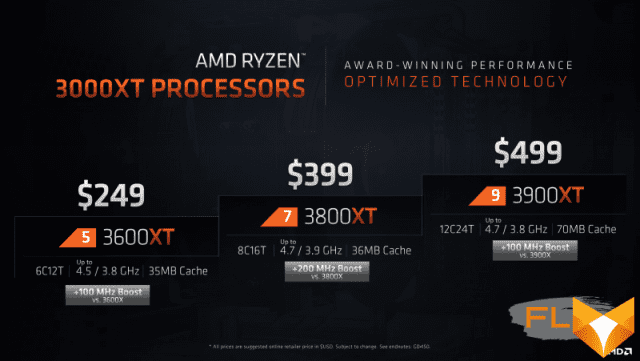
In total, the series of “improved” processors includes three representatives: the 12-core Ryzen 9 3900XT, the eight-core Ryzen 7 3800XT and the six-core Ryzen 5 3600XT, and they fit into the existing lineup as follows.
| Cores/Threads | Base frequency, MHz | Turbo frequency, MHz | L3 cache, MB | TDP, W | Chiplets | Price | |
|---|---|---|---|---|---|---|---|
| Ryzen 9 3950X | 16/32 | 3.5 | 4,7 | 64 | 105 | 2×CCD + I/O | $749 |
| Ryzen 9 3900XT | 12/24 | 3.8 | 4,7 | 64 | 105 | 2×CCD + I/O | $499 |
| Ryzen 9 3900X | 12/24 | 3,8 | 4,6 | 64 | 105 | 2×CCD + I/O | |
| Ryzen 7 3800XT | 8/16 | 3.9 | 4,7 | 32 | 105 | CCD + I/O | $399 |
| Ryzen 7 3800X | 8/16 | 3.9 | 4,5 | 32 | 105 | CCD + I/O | |
| Ryzen 7 3700X | 8/16 | 3,6 | 4,4 | 32 | 65 | CCD + I/O | $329 |
| Ryzen 5 3600XT | 6/12 | 3.8 | 4.5 | 32 | 95 | CCD + I/O | $249 |
| Ryzen 5 3600X | 6/12 | 3,8 | 4,4 | 32 | 95 | CCD + I/O | |
| Ryzen 5 3600 | 6/12 | 3,6 | 4,2 | 32 | 65 | CCD + I/O | $199 |
Based on the passport characteristics, it begins to seem that with the release of the Ryzen 3000XT, AMD is trying to sell its adherents the same Matisse, which has been on the market for a year, for the second time. However, AMD itself objects to this that not all the advantages of the Ryzen 3000XT can be traced in the specifications, and much more can supposedly be expected from the new processors:
- 4-5% performance increase for single-threaded and low-threaded workloads;
- easier achievement of maximum frequencies with low-flow loads;
- Higher operating frequencies for medium workloads in creative applications where performance gains can be up to 10%;
- Major performance improvements in some games that are CPU-sensitive;
- but at the same time a subtle improvement in performance in heavy workloads, where the frequency of the processor is limited by current consumption and heat dissipation.
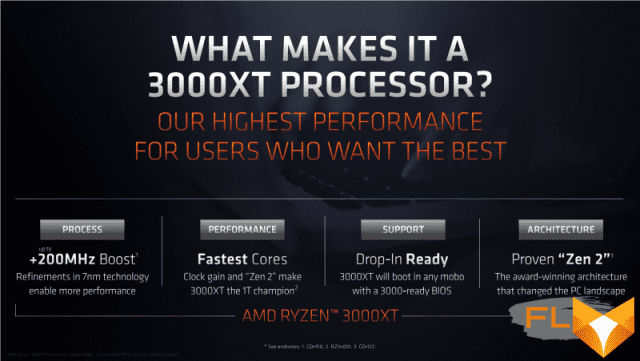
In other words, AMD clearly says that processors with the XT suffix in the name are noticeably better optimized for applications that do not take all available resources and do not load all available threads and cores. This means that you should not expect any noticeable improvements in terms of energy efficiency from the new processors, but at the same time, it seems that they can maintain stability at higher frequencies compared to their predecessors. We will continue to test this thesis, focusing on testing two senior representatives of the new series: the 12-core Ryzen 9 3900XT and the eight-core Ryzen 7 3800XT.
⇡#Ryzen 9 3900XT
There is no need to elaborate on the specifications of the Ryzen 9 3900XT. This is almost the same processor as the 12-core Ryzen 9 3900X, which has been on the market for a year now. It is based on three semiconductor crystals: two 7nm eight-core CCD chips with computing cores (each of which has two cores hardware locked) and one 12nm IOD chiplet, which houses the memory controller, Infinity Fabric logic, PCI Express controllers and other binding.

Due to the use of two CCD chipsets at once, such a processor has a giant third-level cache memory of 64 MB and has 12 computing cores, which are divided into four CCX complexes, each of which has three cores and is located in a 16 MB cache segment. All these components are connected into a single whole by the proprietary Infinity Fabric bus.
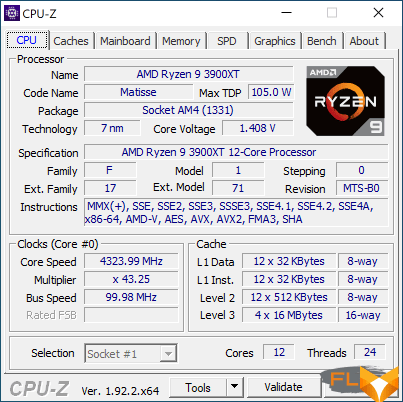
The Ryzen 9 3900XT is clocked in the 3.8 to 4.7 GHz range, which formally means that the new processor can overclock 100 MHz more than the Ryzen 9 3900X. At the same time, the Ryzen 9 3900XT retains a TDP of 105W and a 142W power consumption limit.
The slightly higher frequency achievable in turbo mode is not the only difference between the Ryzen 9 3900XT and the Ryzen 9 3900X. Another significant point concerns the configuration. While the Ryzen 9 3900X comes with a Wraith Prism cooler in the box, the new Ryzen 9 3900XT lacks any stock cooler. With it, AMD offers to use separately purchased powerful liquid cooling systems, which it previously recommended for the Ryzen 9 3950X.

But the most interesting point regarding the Ryzen 9 3900XT is not reflected in the passport characteristics, and it is impossible to understand by what law the frequency of this processor depends on the load. Although it is here, if you believe what AMD says, that the main advantage of the Ryzen 9 3900XT over the Ryzen 3900X should appear. This omission had to be eliminated by practical testing. On a system with a Ryzen 9 3900XT, we ran the Cinebench R20 rendering test with various limits on the number of threads involved – and looked at what average frequency the processor was running in each case. The resulting Ryzen 9 3900XT frequency versus load graph is shown below. For clarity, a similar curve is plotted on it, built for the Ryzen 9 3900X.
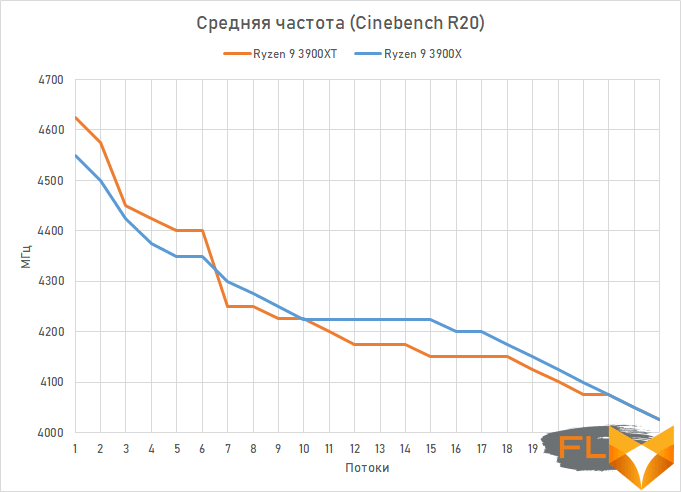
And here it turns out: a lot of what AMD promised about the Ryzen 3000XT series processors, to put it mildly, does not correspond to reality. There is no “easier achievement of maximum frequencies with low-threaded loads” in reality, and in general, the situation with the frequencies of the Ryzen 9 3900XT looks more like “we treat one thing and cripple another”. Yes, the new processor is slightly faster in light, low-threaded workloads, and with up to six threads, it is 50-100 MHz faster than the Ryzen 9 3900X. But when the load increases and extends to a larger number of threads, a higher clock frequency of 50-100 MHz is already able to offer the Ryzen 9 3900X a year ago. The frequencies of the old and new 12-cores equalize only at the maximum multi-threaded load, when more than 22 of the 24 available threads are loaded with work. Consequently, the Ryzen 9 3900XT will not always be more productive than its predecessor, but only in some selected applications that can only use a very limited number of cores. And this is a rather strange approach, since against the backdrop of the Ryzen 9 3900X, the new Ryzen 9 3900XT immediately looks like an absurd multi-core processor optimized for low-threaded applications.
How AMD managed to produce such a product is easy to explain. To do this, it suffices to recall that 12-core processors are assembled from two chiplets, which radically differ in properties. To illustrate this difference with our Ryzen 9 3900XT instance, we have compiled a set of charts that show the dependence of operating frequencies and power consumption for each individual core under varying load intensity. All of this data was obtained by running a series of Cinebench R20 rendering tests.

As you can see, AMD’s approach to building the Ryzen 9 3900XT hasn’t changed. The first CCD chiplet in it is aimed at conquering high frequencies: it is selected from crystals with high leakage currents, which scale better in frequency, but at the same time have noticeably higher energy appetites. The second chiplet is energy efficient silicon, which should have reduced consumption at limited frequencies.
The results confirm that the first chiplet in the Ryzen 9 3900XT is a selective semiconductor die that can indeed reach higher frequencies than the Ryzen 9 3900X takes in turbo mode. The second chiplet is aimed at energy efficiency and is not designed for high frequencies at all – it is he who causes the Ryzen 9 3900XT to severely limit operating frequencies with multi-threaded loads.
If you look at the consumption dependence of the Ryzen 9 3900XT and Ryzen 9 3900X when using a different number of threads in Cinebench R20, it turns out that if we are not talking about minimum or maximum loads, then the new processor is more economical. The noticeably increased appetites of the first chiplet are balanced in it by the improved efficiency of the second: while the cores of the first CCD chiplet can demonstrate consumption up to 15 W, the maximum consumption of the cores of the second chiplet is limited to 12 W.
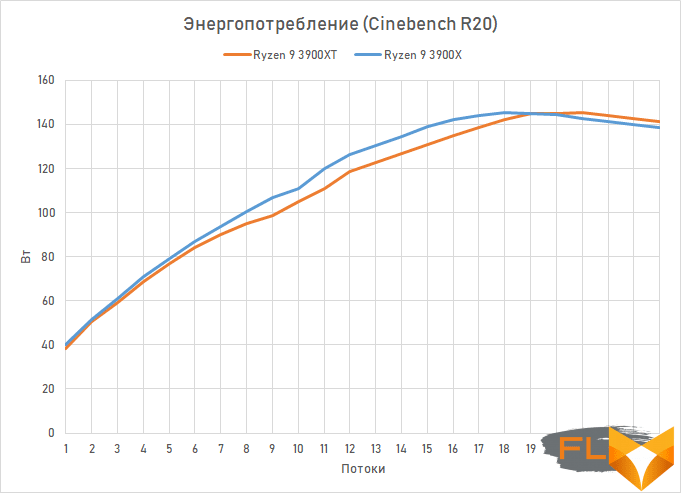
It remains to clarify the situation with temperatures: after all, it is probably not in vain that high-performance liquid cooling is now recommended for the Ryzen 9 3900XT. And the illustration here is very simple: the following graph plots the temperatures of the Ryzen 9 3900XT and Ryzen 9 3900X in the Cinebench R20 test with a load on a different number of cores. To cool the processor in this test, a self-assembled liquid cooling system built on EKWB components was used.

The result is predictable: due to the peculiarities of the semiconductor crystals used, the Ryzen 9 3900XT, all other things being equal, operates at higher voltages and, as a result, heats up several degrees more than its predecessor. Therefore, a high-performance cooling system really does not hurt here.
It turns out that the Ryzen 9 3900XT is a very strange novelty. It is hotter and slower than last year’s Ryzen 9 3900X already on the market, except for one situation – low-threaded workloads.
However, we should not forget that different instances of processors may have some variation in electrical and thermal characteristics due to the fact that the selection procedure for crystals gives some error. Therefore, it is impossible to exclude the possibility that among the serial Ryzen 9 3900XT processors there will be instances that will not be inferior to the Ryzen 9 3900X over the entire load range.
⇡#Ryzen 7 3800XT
The performance differences between the new octa-core Ryzen 7 3800XT and the previous Ryzen 7 3800X are more noticeable than in the case of 12-cores, but they are again limited by the difference in the maximum frequency in turbo mode. For the Ryzen 7 3800XT, a frequency range of 3.9-4.7 GHz is declared, which means that this processor can automatically overclock at low-threaded loads by 200 MHz more than its predecessor.
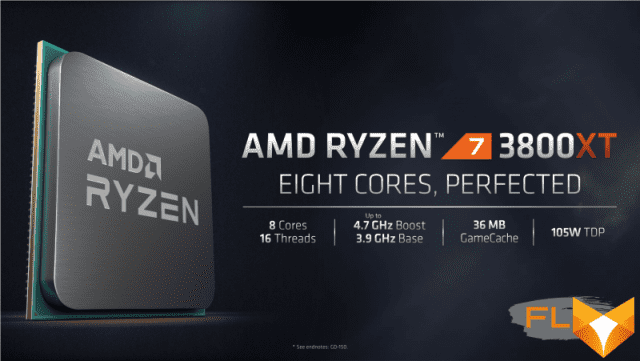
Otherwise, the specifications are completely the same: a base frequency of 3.9 GHz, 32 MB of third-level cache, a 105 W thermal package and a maximum power consumption of 142 W. At the same time, the manufacturer also did not complete the Ryzen 7 3800XT with a standard cooling system, recommending that users purchase liquid cooling systems on their own, while the Wraith Prism air cooler was put into the boxes with the Ryzen 7 3800X. All this suggests that the Ryzen 7 3800XT, like its 12-core counterpart, is characterized by stronger heating compared to its predecessor, which was already characterized by near-critical operating temperatures and was even named by us as a heating champion.
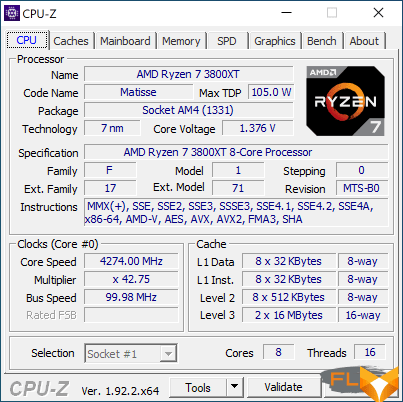
The Ryzen 7 3800XT includes one eight-core CCD chip, so AMD should have no problems choosing a high-frequency semiconductor filling for it. If the manufacturer’s words about improving the properties of TSMC’s 7nm process technology are true, then you can really expect superiority from the Ryzen 7 3800XT over the year-old Ryzen 7 3800X under any load conditions, and not just in the case of the activity of one or two cores.
And this is confirmed by the results of a natural experiment. Comparing the frequencies of the Ryzen 7 3800XT and Ryzen 7 3800X under load with various numbers of threads in the Cinebench R20 rendering test shows that the new processor is indeed faster by 100 MHz in multi-threaded workloads and by almost 200 MHz in single- or dual-threaded workloads.

In other words, there really is some forward movement here, and not in the same way as in the case of the new 12-core. That is, the Ryzen 7 3800XT has the right to be considered a further development of the Matisse series. Moreover, the increase in frequency and, accordingly, the performance of the Ryzen 7 3800XT occurred almost without an increase in power consumption.

However, there are still pitfalls. The temperature regime of the Ryzen 7 3800XT cannot be called favorable. Even when we tested the Ryzen 7 3800X, the main complaint about the older eight-core was that it got very hot and reached temperatures over 90 degrees even when using powerful air coolers. And the Ryzen 7 3800XT requires higher supply voltages (by about 0.025 V) for its operation and heats up even more than its predecessor. The graph below shows the temperatures of the eight-core novelty in Cinebench R20, obtained with a custom liquid cooling system based on EKWB components with a 360 mm radiator.
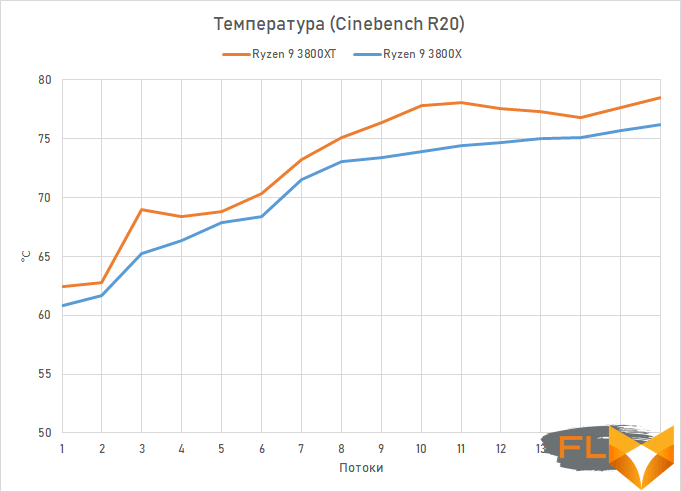
The operating temperatures of the Ryzen 7 3800XT are several degrees higher than those of the Ryzen 7 3800X, and it is clear that an air cooler will not be enough here, and AMD recommends high-performance coolants for the new processor for a reason. The following screenshot can be cited as proof, showing that the Ryzen 7 3800XT, even with a powerful self-assembly LSS, can warm up to almost 90 degrees – such heating is obtained in Prime95 29.8, that is, where AVX2 instructions come into play.
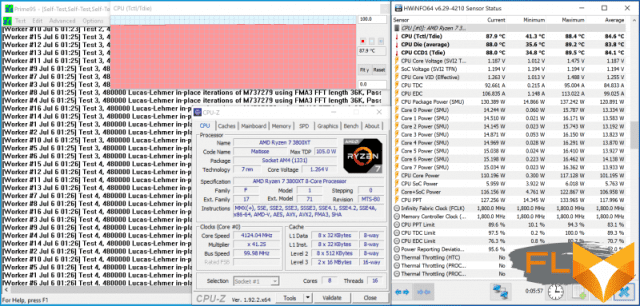
Thus, it becomes obvious that when choosing a Ryzen 7 3800XT processor as the basis of a computer, you will have to add a significant amount to a high-performance cooling system to its $ 400 price. Otherwise, the frequency potential of the new silicon may not be revealed, since the dynamic frequency control technology used in Ryzen will reset the frequencies due to the temperature going out of range.
⇡#Overclocking
Be that as it may, the Ryzen 3000XT series processors do use 7nm crystals, capable of conquering higher peak frequencies than before. The progress achieved cannot be called cardinal, but it is there: in turbo mode, new processors are able to take 100-200 MHz higher frequencies. This should probably have a positive effect on the overclocking potential.
There is an opinion among enthusiasts that after a year after the announcement, even conventional Ryzen 3000 processors began to overclock better on average than those CPUs that hit store shelves last summer. This means that the Ryzen 3000XT series should become even more overclocking, because for it the manufacturer purposefully selects the most frequency-compliant silicon. And the results of the experiments as a whole confirm this theory.
So, based on a single 7nm CCD chip and a simpler internal topology, the Ryzen 7 3800XT processor was able to overclock in our experiments to a frequency of 4.35 GHz with a stability test in Prime95 29.8. At the same time, the processor voltage had to be set to 1.25 V with the maximum Load-Line Calibration level (according to the BIOS of the motherboard), but under high load it still sagged to 1.212 V.

With these settings, we managed to keep the CPU temperature within 100 degrees, but it is worth recalling that a productive liquid cooling system was responsible for the heat removal in our experiments.
From the above screenshot, you can see that the power consumption of the processor during overclocking is only 150 watts, but its temperature is approaching a critical limit, and this may surprise some. After all, if we were talking about Intel processors, then such temperatures of processor cores would appear only when consumption approaches the 300-watt mark. But the high temperature of the Ryzen 7 3800XT has an explanation: the transition to the 7nm process led to it. While thinner manufacturing standards allow for improved energy efficiency of chips, removing heat from small semiconductor dies (and a standard eight-core CCD chiplet has an area of only 74mm2), it becomes much more difficult as they generate much higher density heat flow. It is for this reason that overclocking of Ryzen processors quickly runs into temperature rise, no matter how powerful the cooling system used.
Nevertheless, overclocking to 4.35 GHz for the eight-core Ryzen 7 3800XT is a pretty good result. Typical Ryzen 7 3800X overclock to 4.2-4.3 GHz, and Ryzen 7 3800XT, although not as much, but still managed to go beyond this interval. And this means that with an eye to overclocking, the Ryzen 7 3800XT is the most attractive option among AMD’s eight-core processors.
With overclocking of the 12-core Ryzen 9 3900XT, things are more complicated. This processor uses two 7nm CCD chips with different properties at once, and the second die in this pair initially does not promise much flexibility in frequency. That is why when overclocking regular Ryzen 7 3900X, difficulties often arise, and some instances above 4.0-4.1 GHz are not taken at all during synchronous overclocking of all cores.
But the Ryzen 9 3900XT that came into our possession turned out to be clearly more successful than most of the old Ryzen 9 3900X. By raising the VCORE voltage in the motherboard BIOS to 1.25V, it was able to run fully stable at 4.2GHz while stress testing in Prime95 29.8.
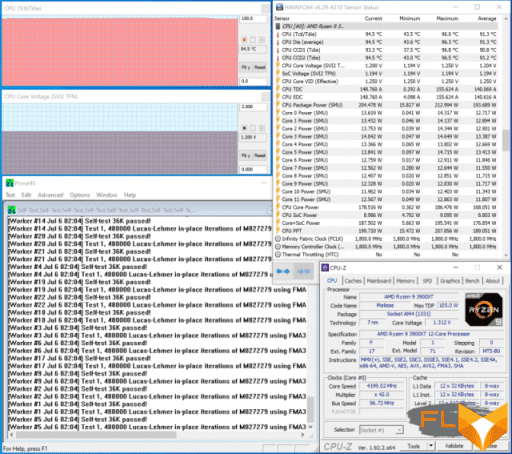
The temperatures of both CCD chips during the stress test were 94-96 degrees, the total processor consumption reached 213 watts. By the way, pay attention to how this value is distributed between the crystals. The core of the first CCD chiplet consumes 86 watts, while the cores of the second one consume only 76 watts. This is where the difference in leakage currents of CCD crystals manifests itself: at equal frequency and voltage, the first one consumes about 13% more, but in the end it is able to take higher frequencies.
In general, the Ryzen 9 3900XT we got did not set overclocking records, but processors capable of operating at a frequency of 4.2 GHz (with honest stability testing in Prime95) were rare among the Ryzen 9 3900X. For example, according to the statistics of the Silicon Lottery store of overclocking processors, the share of such processors in their sample was about 6%. And in the case of the Ryzen 9 3900XT, the first instance that came across was able to work at 4.2 GHz.
So, the Ryzen 9 3900XT confirms the general rule: processors with the XT index overclock better than their predecessors.
⇡#Description of test systems and testing methodology
The performance tests of the Ryzen 9 3900XT and Ryzen 7 3800XT were carried out in the most logical line-up of rivals: they were opposed, on the one hand, by their predecessors, Ryzen 9 3900X and Ryzen 7 3800X, and on the other hand, by rival processors Core i9-10900K and Core i7-10700K.
Adding the necessary components to them and several processors close in positioning, we got the following list of components involved in testing:
- Processors:
- AMD Ryzen 9 3950X (Matisse, 16 cores + SMT, 3.5-4.6GHz, 64MB L3);
- AMD Ryzen 9 3900XT (Matisse, 12 cores + SMT, 3.8-4.7GHz, 64MB L3);
- AMD Ryzen 9 3900X (Matisse, 12 cores + SMT, 3.8-4.6GHz, 64MB L3);
- AMD Ryzen 7 3800XT (Matisse, 8 cores + SMT, 3.9-4.7GHz, 32MB L3);
- AMD Ryzen 7 3800X (Matisse, 8 cores + SMT, 3.9-4.5GHz, 32MB L3);
- AMD Ryzen 7 3700X (Matisse, 8 cores + SMT, 3.6-4.4GHz, 32MB L3);
- Intel Core i9-10900K (Comet Lake, 10 cores + HT, 3.7-5.3GHz, 20MB L3);
- Intel Core i9-9900K (Coffee Lake Refresh, 8 cores + HT, 3.6-5.0 GHz, 16MB L3);
- Intel Core i7-10700K (Comet Lake, 8 cores + HT, 3.8-5.1 GHz, 16MB L3).
- CPU cooler: Noctua NH-D15.
- Motherboards:
- ASRock X570 Taichi (Socket AM4, AMD X570);
- ASRock Z390 Taichi (LGA1151v2, Intel Z390);
- ASUS ROG Maximus XII Hero (Wi-Fi) (LGA 1200, Intel Z490).
- Memory: 2 x 8GB DDR4-3600 SDRAM, 16-16-16-36 (G.Skill Trident Z RGB F4-3600C16D-16GTZR).
- Video Card: NVIDIA GeForce RTX 2080 Ti (TU102, 1350/14000MHz, 11GB GDDR6 352-bit).
- Disk subsystem: Samsung 970 EVO Plus 2TB (MZ-V7S2T0BW).
- Power supply: Thermaltake Toughpower DPS G RGB 1000W Titanium (80 Plus Titanium, 1000W).
All compared processors were tested with the settings accepted by the board manufacturers by default. This means that for Intel platforms, the power consumption limits indicated in the specifications are ignored, and instead the maximum possible frequencies are used in order to obtain maximum performance. The vast majority of users operate processors in this mode, since enabling heat dissipation and power consumption limits in most cases requires special BIOS settings. The same goes for AMD processors. As it turned out recently, a large number of Socket AM4 motherboards deliberately distort the telemetry information transmitted to the processors in order to achieve higher operating frequencies from them, which formally go beyond the modes defined by the specifications.
All compared processors were tested with memory operating in DDR4-3600 mode with XMP timing settings.
Testing was performed on the Microsoft Windows 10 Pro (v1909) Build 18363.476 operating system using the following driver set:
- AMD Chipset Driver 2.04.04.111;
- Intel Chipset Driver 10.1.31.2;
- NVIDIA GeForce 445.87 Driver.
Description of the tools used to measure computing performance:
Comprehensive benchmarks:
- Futuremark PCMark 10 Professional Edition 2.1.2177 – testing in Essentials scenarios (typical work of the average user: launching applications, surfing the Internet, video conferencing), Productivity (office work with a word processor and spreadsheets), Digital Content Creation (creating a digital content: photo editing, non-linear video editing, rendering and visualization of 3D models).
- 3DMark Professional Edition 2.11.6846 – testing in the Time Spy Extreme 1.0 scene.
Applications:
- 7-zip 19.00 – archiving speed testing. The time taken by the archiver to compress a directory with various files with a total volume of 3.1 GB is measured. Uses LZMA2 algorithm and maximum compression ratio.
- Adobe After Effects CC 2020 17.0.1 – Animation movie rendering speed test. The time taken by the system to render a pre-prepared video in 1920 × 1080@30fps resolution is measured.
- Adobe Photoshop CC 2020 21.0.2 – Graphics performance test. The average execution time of the Puget Systems Adobe Photoshop CC Benchmark 18.10 test script, which simulates the typical processing of an image taken by a digital camera, is measured.
- Adobe Photoshop Lightroom Classic CC 9.1 – performance testing for batch processing of a series of images in RAW format. The test scenario includes post-processing and export to JPEG at a resolution of 1920 × 1080 and a maximum quality of two hundred 16-megapixel RAW images taken with a Fujifilm X-T1 digital camera.
- Adobe Premiere Pro CC 2020 14.0 – Performance testing for non-linear video editing. Measures rendering time to YouTube 4K for a project containing HDV 2160p30 footage with various effects applied.
- Blender 2.82a – testing the speed of the final rendering in one of the popular free packages for creating three-dimensional graphics. The duration of building the final model pavillon_barcelona_v1.2 from Blender Benchmark is measured.
- Corona 1.3 – testing rendering speed using the same-named renderer. The standard application Corona 1.3 Benchmark is used to measure performance.
- Microsoft Visual Studio 2017 (15.9.17) – compile time measurement of a large MSVC project – a professional package for creating 3D graphics Blender version 2.79b.
- Stockfish 11 – testing the speed of the popular chess engine. The speed of enumeration of options in the position “1q6/1r2k1p1/4pp1p/1P1b1P2/3Q4/7P/4B1P1/2R3K1 w” is measured.
- SVT-AV1 v0.8.3 – testing the speed of video transcoding to the promising AV1 format. To evaluate performance, we use the original 1080p@50FPS AVC video file with a bitrate of about 30 Mbps.
- Topaz Video Enhance AI v1.2.1 – performance testing in an AI-based program to improve video detail. The test uses the original video at 320×240 resolution, which is scaled up twice using the Artemis-HQ model: P, HQ, MC.
- V-Ray 4.10.03 – testing the performance of a popular rendering system using the standard V-Ray Benchmark Next application.
- x265 3.2+9 10bpp – testing the speed of video transcoding to H.265/HEVC format. Performance is measured using a raw 2160p@24FPS AVC video file with a bitrate of approximately 42 Mbps.
Games:
- Assassin’s Creed Odyssey. Resolution 1920 × 1080: Graphics Quality = Ultra High. Resolution 3840 × 2160: Graphics Quality = Ultra High.
- Civilization VI: Gathering Storm. Resolution 1920×1080: DirectX 12, MSAA=4x, Performance Impact=Ultra, Memory Impact=Ultra. Resolution 2560 × 1440: DirectX 12, MSAA = 4x, Performance Impact = Ultra, Memory Impact = Ultra.
- Far Cry 5. 1920 × 1080 resolution: Graphics Quality = Ultra, HD Textures = On, Anti-Aliasing = TAA, Motion Blur = On. Resolution 3840 × 2160: Graphics Quality = Ultra, Anti-Aliasing = Off, Motion Blur = On.
- Gears 5. Resolution 1920 × 1080: Default Quality = Ultra. Resolution 3840 × 2160: Default Quality = Ultra.
- Hitman 2. 1920 × 1080 resolution: DirectX 12, Super Sampling = 1.0, Level of Detail = Ultra, Anti-Aliasing = FXAA, Texture Quality = High, Texture Filter = Anisotropic 16x, SSAO = On, Shadow Maps = Ultra , Shadow Resolution = High. Resolution 3840 × 2160: DirectX 12, Super Sampling = 1.0, Level of Detail = Ultra, Anti-Aliasing = FXAA, Texture Quality = High, Texture Filter = Anisotropic 16x, SSAO = On, Shadow Maps = Ultra, Shadow Resolution = High.
- Shadow of the Tomb Raider. Resolution 1920×1080: DirectX12, Preset=Highest, Anti-Aliasing=TAA. Resolution 3840 × 2160: DirectX12, Preset = Highest, Anti-Aliasing = Off.
- Total War: Three Kingdoms. Resolution 1920 × 1080: DirectX 12, Quality = Ultra, Unit Size = Extreme. Resolution 3840 × 2160: DirectX 12, Quality = Ultra, Unit Size = Extreme.
- World War Z. 1920 × 1080 resolution: DirectX11, Visual Quality Preset = Ultra. Resolution 3840 × 2160: DirectX11, Visual Quality Preset = Ultra.
In all gaming tests, the results are the average number of frames per second, as well as the 0.01-quantile (first percentile) for FPS values. The use of the 0.01-quantile instead of the minimum FPS is due to the desire to clean up the results from random bursts of performance that were provoked by reasons not directly related to the operation of the main components of the platform.
⇡#Performance in complex tests
In the first part of this material, we analyzed in detail why you should not expect any breakthroughs in performance from the Ryzen 9 3900XT and Ryzen 7 3800XT: they simply have nowhere to come from. And the results obtained in PCMark 10 confirm this. Even in this benchmark, which simulates the user experience in common, common applications, the advantage of new processors over their predecessors is minimal, although in this case the load is predominantly low-threaded. The superiority of new products is most pronounced in the Productivity test scenario dedicated to office work, but even there the performance improved by only 1-3%, despite the fact that AMD promised twice as much.

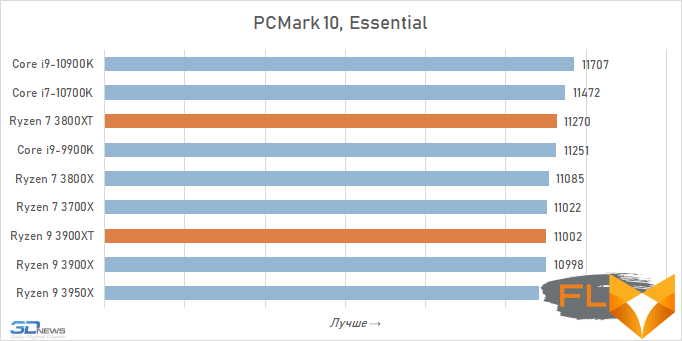
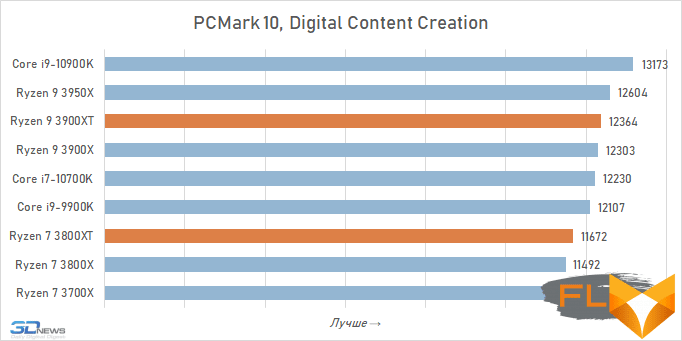
In 3DMark, which to some extent can be considered a measure of gaming performance, the picture is even more pessimistic: there are no differences in the performance of new and old processors at all.
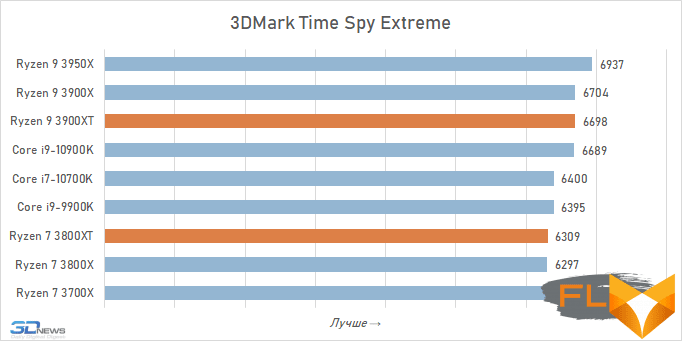

⇡#Performance in Applications
Tests Ryzen 9 3900XT and Ryzen 7 3800XT in resource-intensive tasks lead us to even sadder conclusions. Here, the new processors not only do not show a noticeable superiority over their predecessors in the face of the Ryzen 9 3900X and Ryzen 7 3800X, but often turn out to be corny slower.
First of all, this concerns the new 12-core processor, which more often loses to the Ryzen 9 3900X than bypasses it in terms of speed. But even where the Ryzen 9 3900XT is ahead, its level of superiority is tenths of a percent.
The eight-core Ryzen 7 3800XT looks more fun in this regard. On our set of benchmarks, it’s faster than the Ryzen 7 3800X by about 1.5 percent, with the exception of Topaz Video Enhance AI, where the new processor lags behind its predecessor. This application makes heavy use of power-hungry vector instructions, causing the hotter Ryzen 7 3800XT to drop its frequency as it hits its maximum power limit.
In general, it should be noted that all AMD’s promises about the increase in performance of the Ryzen 3000XT series processors, which allegedly can reach 10%, are nothing more than marketing idle talk. Indeed, there are no such results even close, and it is clearly not necessary to think that with the help of the updated Matisse the company has made some noticeable step forward.
Rendering:
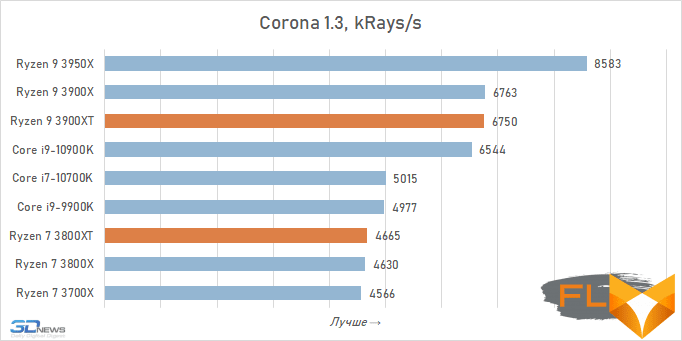
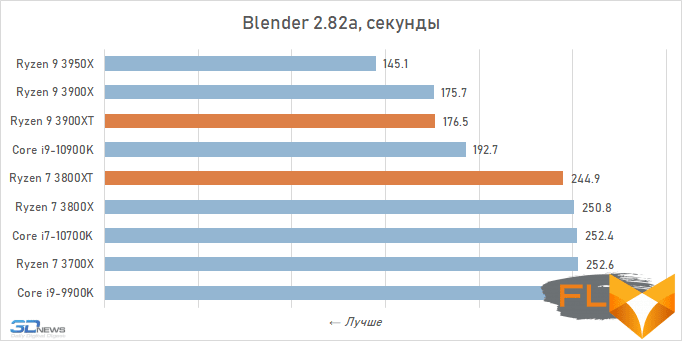
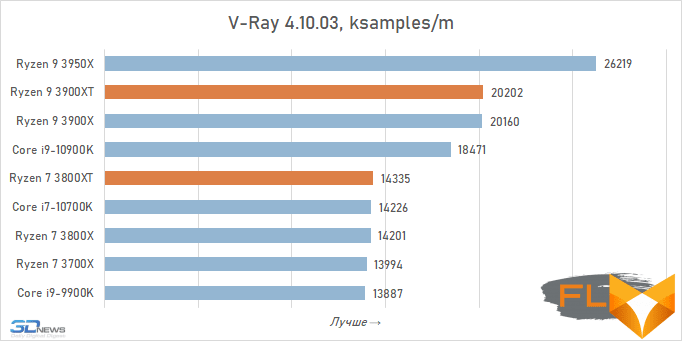
Photo processing:
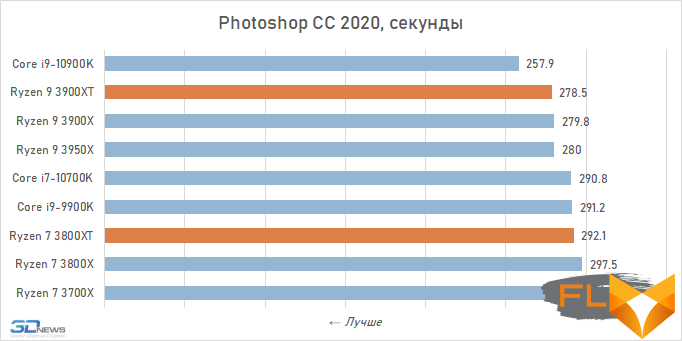

Video work:
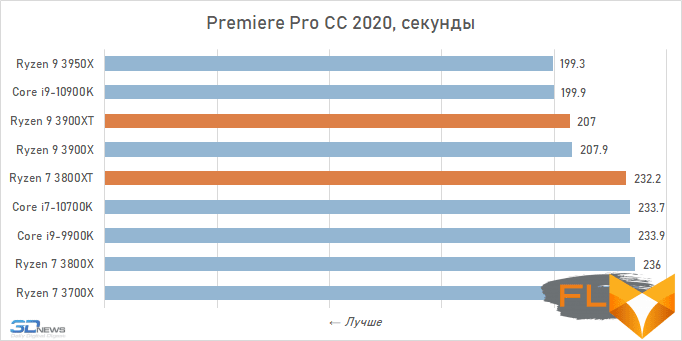
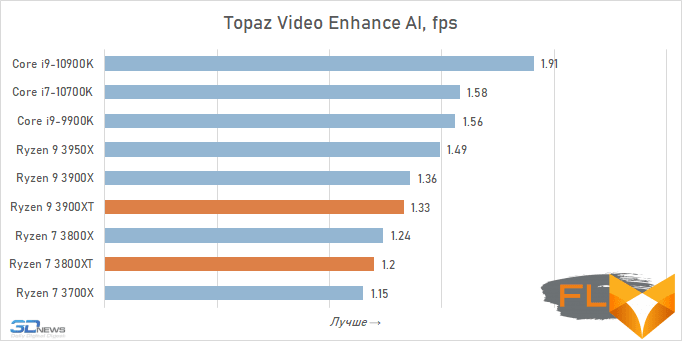
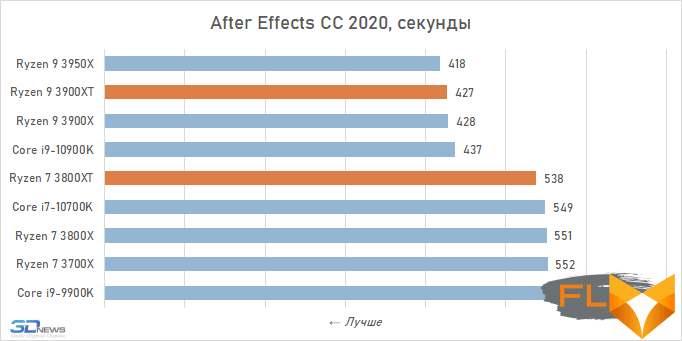
Video transcoding:
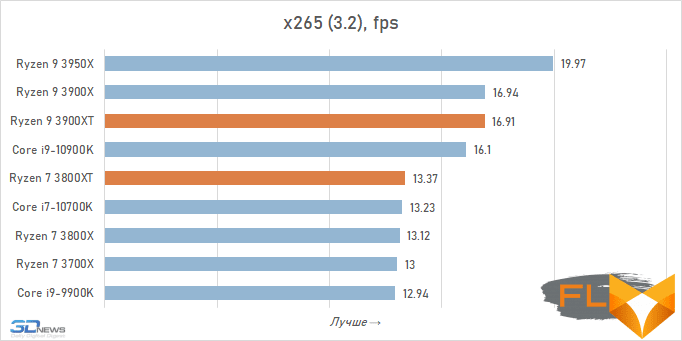
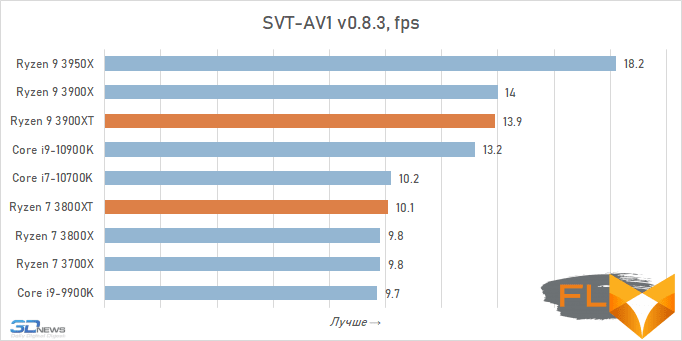
Compilation:
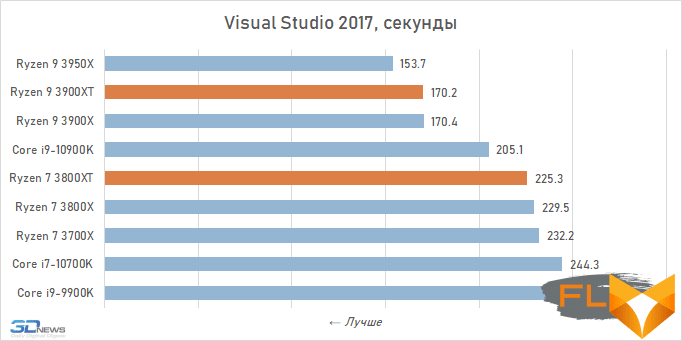
Archiving:
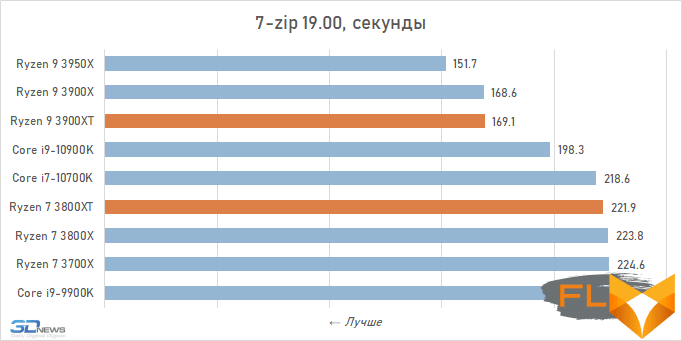
Chess:
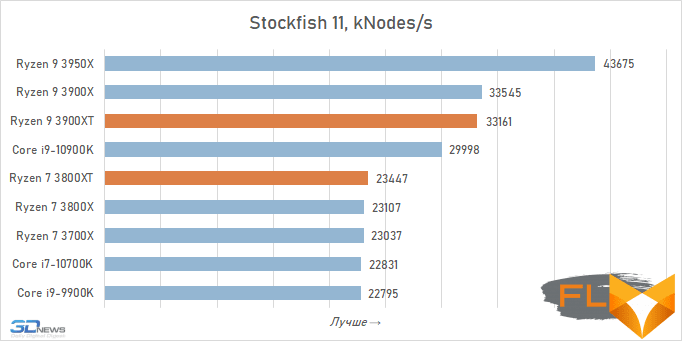
⇡#Tests in 1080p
If the Ryzen 9 3900XT and Ryzen 7 3800XT could not excel in resource-intensive applications, then it is all the more pointless to expect any noticeable success from them in games. In general, new processors with the XT index give out about the same frame rate as their predecessors. It’s better not to go into details, otherwise you can see that the Ryzen 9 3900XT in more cases loses to the old Ryzen 9 3900X. And the Ryzen 7 3800XT may not be inferior to the Ryzen 7 3800X, but its advantage hardly matters, since it is described in tenths of a percent.
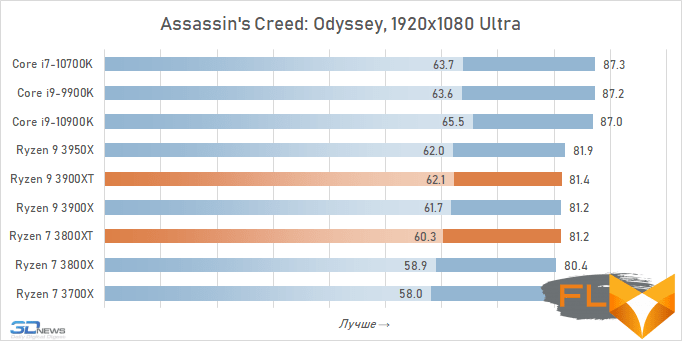
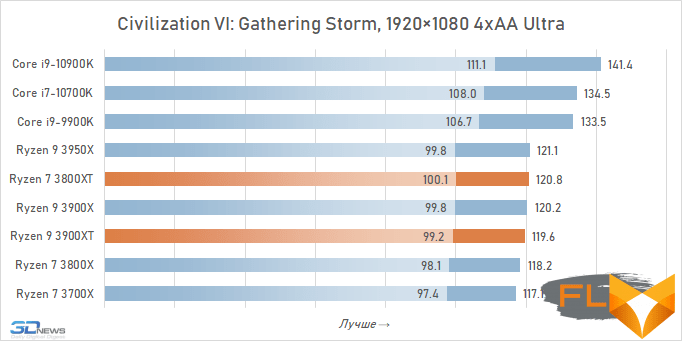
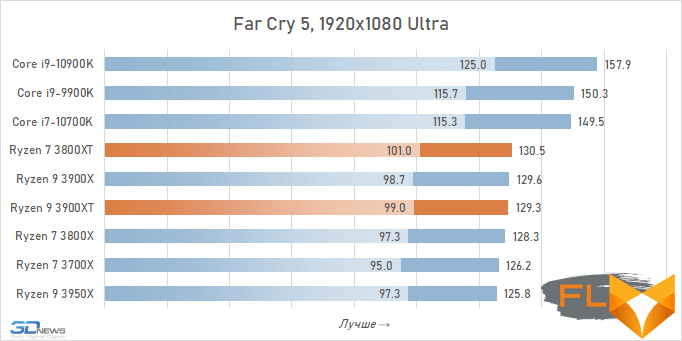
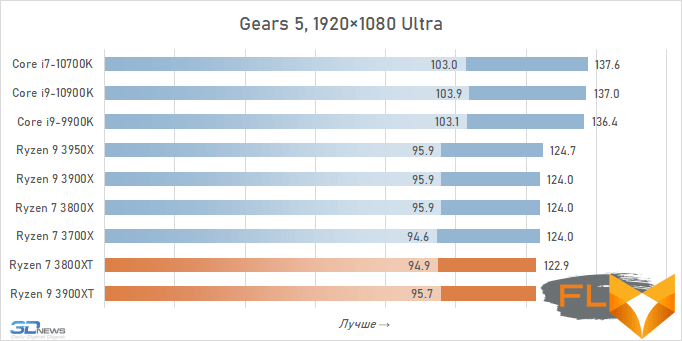
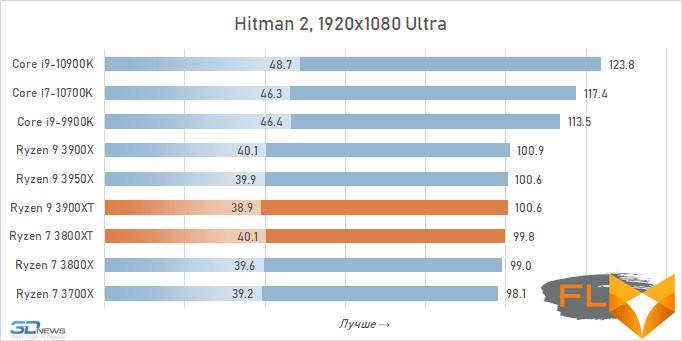
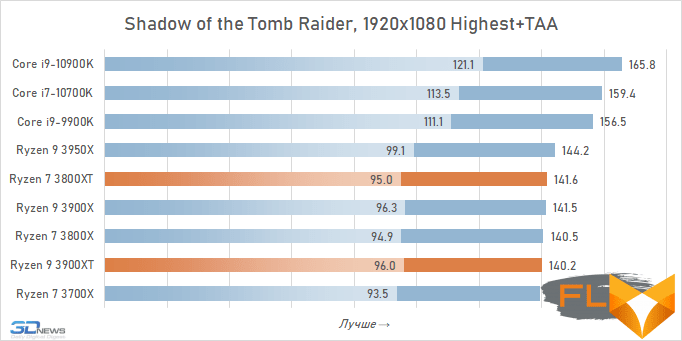
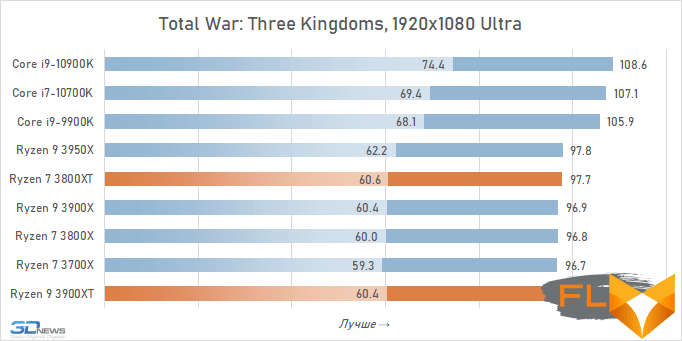
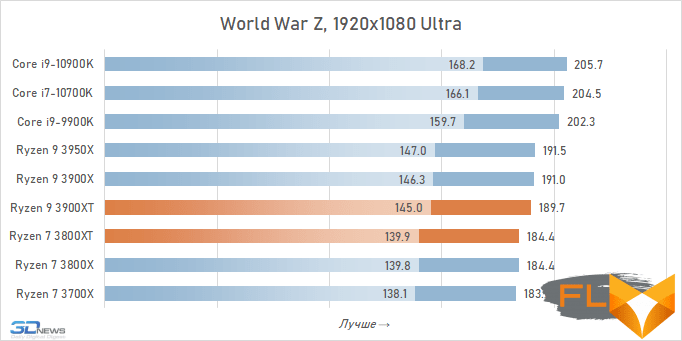
⇡#Tests in 2160p
With the increase in resolution in games, there is no magical transformation of the situation. And if you choose a processor for your gaming system, then there is no point in preferring the newer Ryzen 9 3900XT and Ryzen 7 3800XT. Compared to the Ryzen 9 3900X and Ryzen 7 3800X, they are not at all better in performance, but at the same time their operation is fraught with noticeable difficulties: at the very least, they need more efficient cooling.
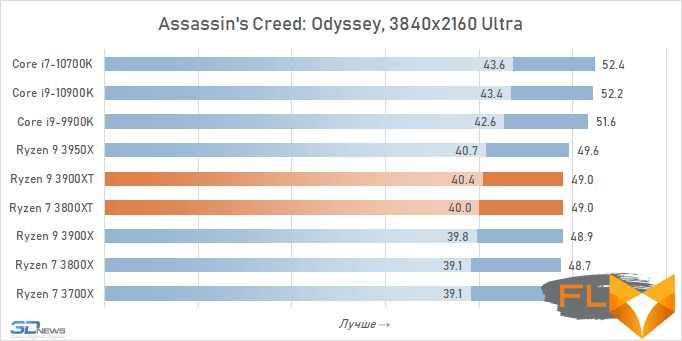
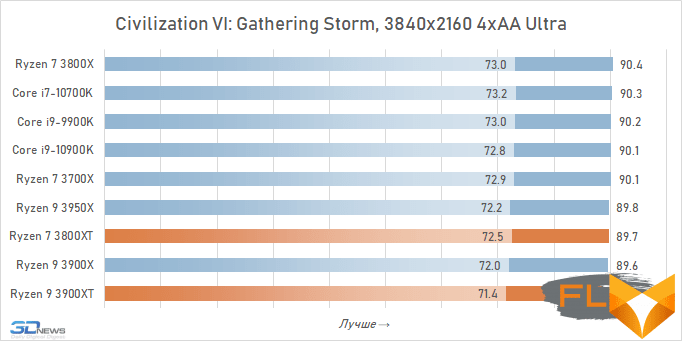
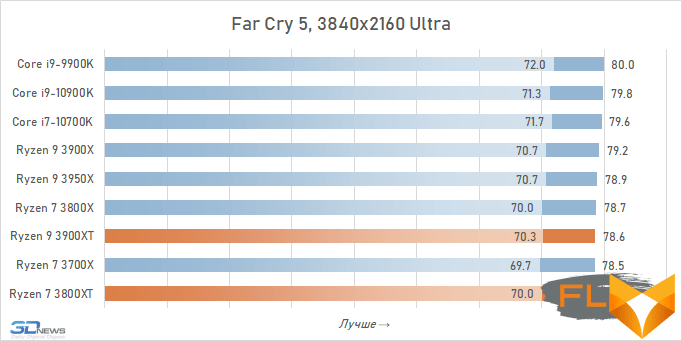

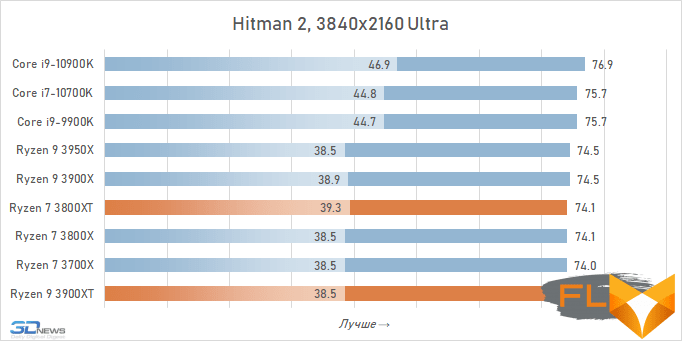

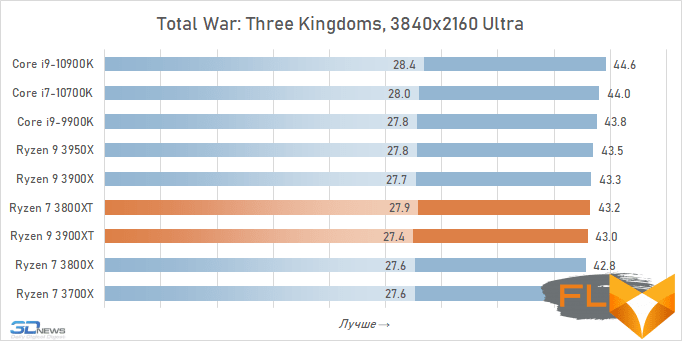
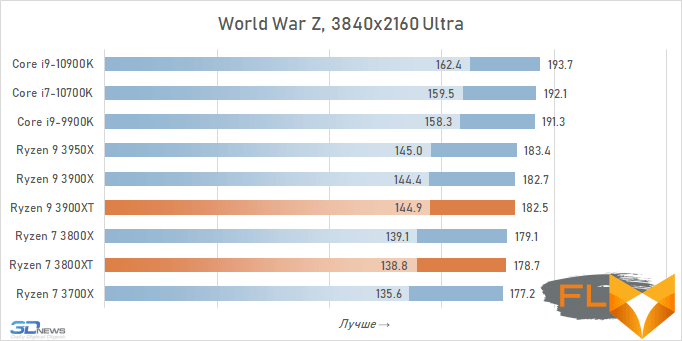
⇡#Power Consumption
In the first part of this material, we already talked about the fact that the Ryzen 3000XT series processors have become more voracious, as they switched to semiconductor crystals with higher leakage currents. Let’s now see how this affects the overall power consumption of systems based on them. The graphs below show the total consumption of the entire platform (without monitor), measured at the output of the power supply.


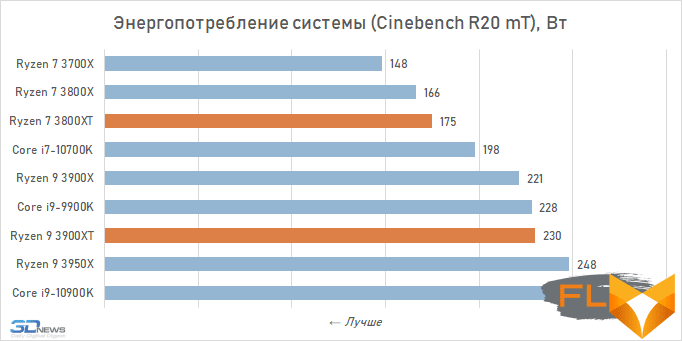

In general, it cannot be said that the Ryzen 9 3900XT and Ryzen 7 3800XT processors somehow noticeably increase the energy appetites of Socket AM4 systems. This is quite natural. They operate within the same constraints as their predecessors, so there is no fundamental change in the consumption situation. However, in some cases, a small increase in consumption at the level of a few watts can be observed.
However, here again it is worth recalling that, despite the rather small difference in consumption, the new processors have noticeably higher performance – especially for the Ryzen 7 3800XT. Therefore, for their operation, it is really better to choose powerful cooling systems, for example, such as those recommended by AMD with coolers with a form factor of 280 mm or more.
⇡#Conclusions
Exactly one year has passed since the release of Matisse processors based on the Zen 2 microarchitecture. To commemorate this milestone, AMD has decided to give its fans a gift of sorts with a new series of “improved” Matisse Refresh processors that the company claims will provide “the best performance for users who want the best” . However, after meeting two representatives of the new series, the 12-core Ryzen 9 3900XT and the eight-core Ryzen 7 3800XT, something doesn’t feel like a holiday. On the contrary, these processors seem to be some kind of tortured novelties that were released more for show than to demonstrate leadership or to meet the needs of some categories of users.
AMD says that the release of the Ryzen 3000XT series was made possible by the systematic improvement of TSMC’s 7nm technology, making the current semiconductor chips better than the past. Perhaps this is true, but in practice something completely different catches the eye. Firstly, processors based on “optimized” silicon turned out to be symbolically faster than their predecessors, and in some cases their real performance even worsened (especially with the Ryzen 9 3900XT). Secondly, the new processors are definitely hotter than their predecessors, and now they need expensive and powerful cooling systems to cool them, while previously the 12- and 8-core Ryzen series processors completely managed with Wraith Prism class air coolers. And thirdly, although AMD says that the Ryzen 3000XT will occupy the same places in the price list that were previously occupied by the corresponding processors released a year ago, in reality this is not entirely true. The cooler is no longer included with the new products, and it is precisely at its price that the new products will be more expensive for end customers.
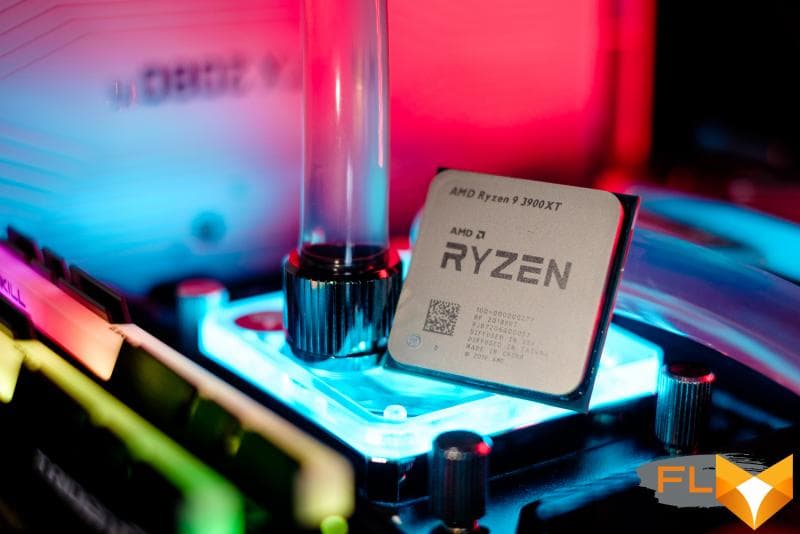
In other words, there are, frankly, no good reasons why the Ryzen 9 3900XT or Ryzen 7 3800XT considered today could be of interest to a wide audience. Their only obvious plus, apparently, concerns only overclocking. Experiments have shown that one can expect a slightly better frequency potential from “optimized” processors, which translates into a distance of the maximum achievable frequency limit by a hundred or two megahertz. But this may be of interest only to radical enthusiasts chasing overclocking records, but not to a wide audience. Ordinary users should be warmed not by the appearance of Ryzen 3000XT processors of little interest to them, but by the fact that, as a result, the positioning of all the others, which have proven themselves as traditional representatives of the Ryzen lineup, will change. AMD openly says that the release of “improved” new products will lead to cheaper Ryzen 9 3900X, Ryzen 7 3800X and Ryzen 5 3600X, and this really cannot but rejoice.
On this, the conversation about the Ryzen 3000XT could well have been completed, but there is another important fact that indirectly affects their appearance. The fact that AMD has decided to release such processors does not mean at all that the main surprise is postponed indefinitely. Today’s announcement is just a light warm-up before the imminent release of Vermeer desktop processors based on the Zen 3 architecture. And now there is no doubt that it will definitely take place this year.
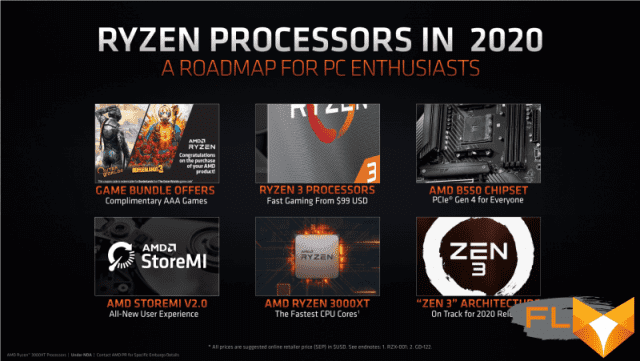
AMD included a slide indicating this in their Ryzen 3000XT presentation, so we will soon return to reviewing new AMD products in a completely different tone.





